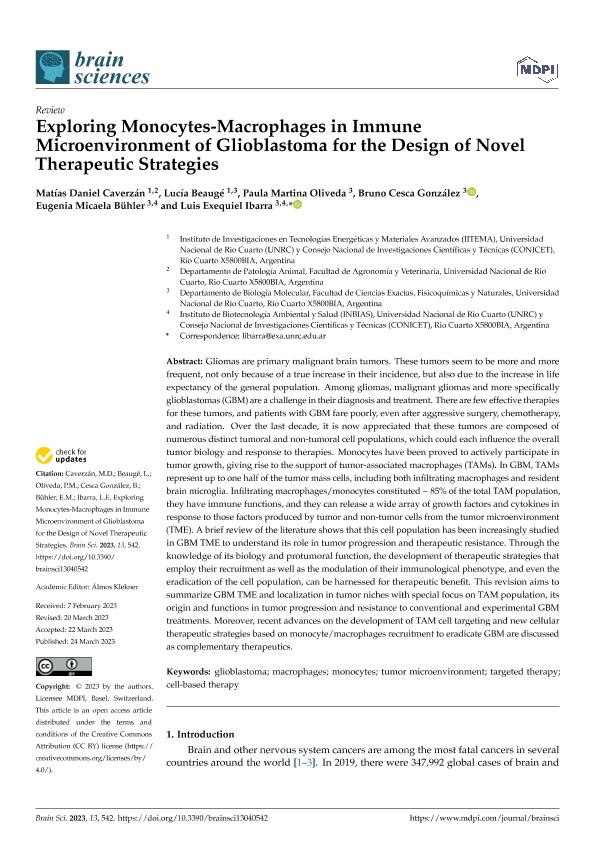Artículo
Exploring Monocytes-Macrophages in Immune Microenvironment of Glioblastoma for the Design of Novel Therapeutic Strategies
Caverzan, Matias Daniel ; Beaugé, Lucía
; Beaugé, Lucía ; Oliveda, Paula Martina; Cesca González, Bruno Agustín; Bühler, Eugenia Micaela
; Oliveda, Paula Martina; Cesca González, Bruno Agustín; Bühler, Eugenia Micaela ; Ibarra, Luis Exequiel
; Ibarra, Luis Exequiel
 ; Beaugé, Lucía
; Beaugé, Lucía ; Oliveda, Paula Martina; Cesca González, Bruno Agustín; Bühler, Eugenia Micaela
; Oliveda, Paula Martina; Cesca González, Bruno Agustín; Bühler, Eugenia Micaela ; Ibarra, Luis Exequiel
; Ibarra, Luis Exequiel
Fecha de publicación:
03/2023
Editorial:
Multidisciplinary Digital Publishing Institute
Revista:
Brain Sciences
ISSN:
2076-3425
Idioma:
Inglés
Tipo de recurso:
Artículo publicado
Clasificación temática:
Resumen
Gliomas are primary malignant brain tumors. These tumors seem to be more and more fre-quent, not only because of a true increase in their incidence, but also due to the increase in life expectancy of the general population. Among gliomas, malignant gliomas and more specifically glioblastomas (GBM) are a challenge in their diagnosis and treatment. There are few effective therapies for these tumors, and patients with GBM fare poorly, even after aggressive surgery, chemotherapy, and radiation. Over the last decade, it is now appreciated that these tumors are composed of numerous distinct tumoral and non-tumoral cell populations, which could each in-fluence the overall tumor biology and response to therapies. Monocytes have been proved to ac-tively participate in tumor growth, giving rise to the support of tumor-associated macrophages (TAMs). In GBM, TAMs represent up to one half of the tumor mass cells, including both infiltrat-ing macrophages and resident brain microglia. Infiltrating macrophages/monocytes constituted ~ 85% of the total TAM population, they have immune functions, and they can release a wide ar-ray of growth factors and cytokines in response to those factors produced by tumor and non-tumor cells from the tumor microenvironment (TME). A brief review of the literature shows that this cell population has been increasingly studied in GBM TME to understand its role in tumor progression and therapeutic resistance. Through the knowledge of its biology and protumoral function, the development of therapeutic strategies that employ their recruitment as well as the modulation of their immunological phenotype, and even the eradication of the cell population, can be harnessed for therapeutic benefit. This revision aims to summarize GBM TME and locali-zation in tumor niches with special focus on TAM population, its origin and functions in tumor progression and resistance to conventional and experimental GBM treatments. Moreover, recent advances on the development of TAM cell targeting and new cellular therapeutic strategies based on monocyte/macrophages recruitment to eradicate GBM are discussed as complementary therapeutics.
Palabras clave:
GLIOBLASTOMA
,
MACROPHAGES
,
MONOCYTES
,
TUMOR MICROENVIRONMENT
,
TARGETED THERAPY
Archivos asociados
Licencia
Identificadores
Colecciones
Articulos (IITEMA)
Articulos de INSTITUTO DE INVESTIGACIONES EN TECNOLOGIAS ENERGETICAS Y MATERIALES AVANZADOS
Articulos de INSTITUTO DE INVESTIGACIONES EN TECNOLOGIAS ENERGETICAS Y MATERIALES AVANZADOS
Articulos (INBIAS)
Articulos de INSTITUTO DE BIOTECNOLOGIA AMBIENTAL Y SALUD
Articulos de INSTITUTO DE BIOTECNOLOGIA AMBIENTAL Y SALUD
Citación
Caverzan, Matias Daniel; Beaugé, Lucía; Oliveda, Paula Martina; Cesca González, Bruno Agustín; Bühler, Eugenia Micaela; et al.; Exploring Monocytes-Macrophages in Immune Microenvironment of Glioblastoma for the Design of Novel Therapeutic Strategies; Multidisciplinary Digital Publishing Institute; Brain Sciences; 13; 4; 3-2023; 542-542
Compartir
Altmétricas



